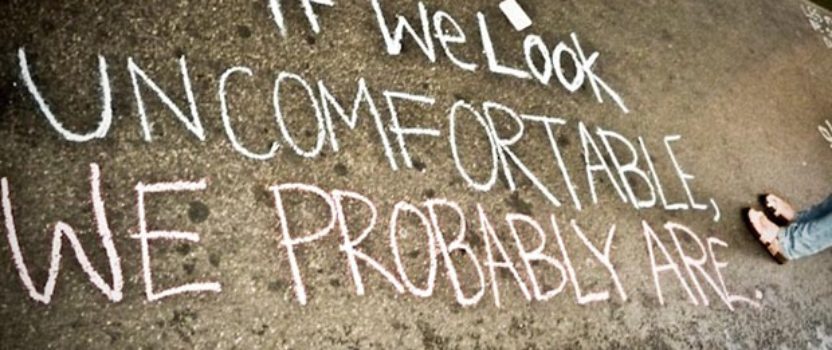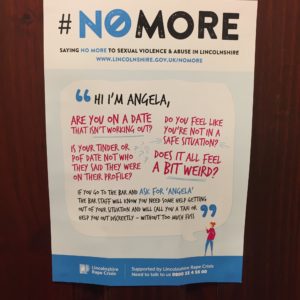What I want is not just a way out – it’s a safer space to be in.
The angel shot.
If you have internet access, you may be one of the millions of people who have seen articles or videos about the “life-saving” properties of the angel shot. We here at CASS have coverage of the angel shot sent to us regularly. A similar approach called “Ask for Angela” has also gone viral. In participating bars, there are typically signs in women’s bathrooms alerting them that they can order an “angel shot” if they feel threatened or wanted to get out of an uncomfortable situation. The bartender will then, theoretically, call the woman a Lyft or walk her to a waiting car.
While this intervention demonstrates an easy, free, and well-intentioned approach to make nightlife safer, it also has some serious flaws that make it at best ineffective and at worst an intervention that perpetuates stigma and avoids addressing root causes of harassment.
We are all for the “yes, and-” approach to addressing harassment (short-term interventions can be critical alongside longer-term culture and policy change), but we worry that these angel shot / ask for Angela sound bites are encouraging establishments to check the box with an incomplete approach rather than doing the critical and radical work of actually creating safer spaces.
The problem with the angel shot — straight up:
- You can guess the first one, can’t you? It only provides this intervention for (some) women. What about men or gender nonconforming people who are harassed? What about women who are harassed by other women – who are now “in” on the lingo? This seems to leave out a huge segment of the population by design, as it functions as a “secret” among one gender hidden from all others. But that’s not how harassment works, and developing an intervention in this way leaves huge numbers of people unprotected and also perpetuates an oversimplified and outdated idea that harassment only occurs between heterosexual men pursuing women (who had to pee earlier in the night). Men, queer, and GNC folks who experience gendered harassment also face stigma. Let’s not make it harder by literally acting as though they never would.
- It necessitates that the person experiencing harassment leaves the venue – rather than the other way around. While many individuals who are feeling bothered or harassed may want to leave, many would likely prefer that the person harassing them is either informed about their unwanted behavior or asked to leave. It also, of course, means that the person who has harassed one customer is presumably free to hang out and bother another. I hope that bar staff would use their judgment to intervene with a repeat offender or if a situation escalated, but that isn’t described in any of the coverage. I have no idea if bar staff at these various “angel shot” establishments are trained in bystander intervention and de-escalation. Calling a Lyft to get this lady outta here? Great — if that’s what she wants in that moment. But it doesn’t really make the space any safer.
- The choices that the shots provide are very limited – and limiting. In most of the “angel shot” iterations, the bar staff can escort you to your ride home (“neat”), call you a Lyft or Uber (“on the rocks”), or call the police (“with a lime”). What if I have to walk or take public transportation home?
This isn’t just nitpicking – this is an intervention designed with a particular type of client in mind, one who can afford cabs to and from the bar, or one who feels safe around police. That is where the potential for support ends.
Further, while I appreciate the right of individuals to decide whether they want to call the police, it is worrisome that this is designed without any deescalation or intervention training to complement it.
What I would want to see written in all bathrooms and in the main rooms of the bar is something akin to: “We don’t tolerate harassment here, and our staff is trained to intervene. Feeling uncomfortable? Let us know.” Not only does that alert me to the presence of trained staff and open up options, but it also promotes prevention by letting would-be harassers know that this seeks to be a safe. space. for everybody.
This is not a condemnation of the angel shot or other similar simple interventions. The vast majority of bars and restaurants haven’t yet grappled with their role in sustaining unsafe spaces, and I’m always grateful to hear about establishments that are acknowledging the problem and working to address it. The angel shot approach does get a few things right: 1) It is essential to have staff as allies; 2) individuals must be able to decide and define what makes them uncomfortable – and seek support in addressing it; and 3) individuals should have both privacy and choice in how they want to respond to any incident of harassment.
Still, what I want is not just a way out – it’s a safer space to be in.
I want bar and nightlife staff to be trained to prevent, de-escalate, and respond to harassment. I want owners to see themselves as allies in this critical work, both for their customers and their own teams. I want people of all genders and sexual orientation to have tools to address the problem and see themselves in the solution – even if it’s a bit more involved than walking someone to her car.
Our Safe Bar Collective is working to tackle root causes of harassment by using training, safety messaging, improved policies and procedures, resources, and promotion of equitable hiring practices to equip bar and restaurant staff with the tools they need to cultivate safer environments.
Our bystander intervention training teaches bar staff to recognize and respond to sexual harassment and everyday microaggressions, better managing the safety of their establishments and preventing escalation and physical or sexual assault from occurring. As we continue to expand our network of trained bars locally, we hope that similar interventions will become more widespread globally.
To learn more, visit a trained bar, share your story, or volunteer, check out the Safe Bar Collective website here.



